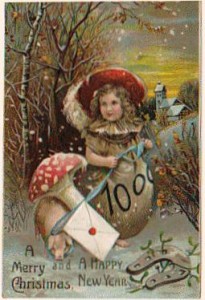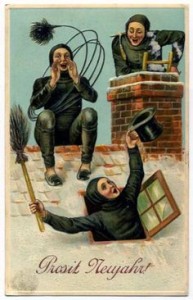Weird New Year’s traditions predate recorded history, blending over time with winter solstice and eventually the Christmas season to form a circus of wonderful winter strangeness. Everyone feels the magic when the clock strikes midnight on New Year’s Eve and the old year expires at last and the sparkling new year is born. Toasts are made, kisses exchanged, balls dropped, and fireworks race skyward dazzling the night.
In our current calendar, New Year’s Eve coincides with either the sixth or seventh day of Christmas, depending upon whether you start counting on Christmas Day or the day after. In the Catholic Church, New Year’s Eve is also Saint Sylvester’s day. Sylvester had the good fortune to be pope in the fourth century when Roman emperor Constantine ceased persecution of Christians and converted. In legend, Sylvester was supposed to have cured Constantine of leprosy and been granted primacy over Western Europe in return, which was a very beneficial fiction for the papacy, deeming the pope’s power greater than that of political rulers.
New Year’s Eve, literally called Silvester in Germany, is a time for protection and fertility rites. Northern European folk rituals include fashioning fresh-cut elder into a wheel and taking it into the house as protection against fire. According to Christian Ratsch in Pagan Christmas, “In Frankonia, on Christmas and Sylvester night, you take a handful of different varieties of corn and mix it in a baking bowl with clover. And then you give it to the animals, in order to ward off witches.” Horses were fed stolen cabbage (stolen from whom?) to keep them in good health, and fruit trees made fertile by beating them with little sacks of peas (see wassailing below). And death can be warded off for the coming year by making a broth of wild pears and placing it on the threshold of the house at midnight, New Year’s Eve.
Additional protection against accidents and maladies for the coming year is afforded by eating three rose hips each on Christmas Eve, St. Stephen’s Day (December 26), New Year’s Eve, and New Year’s Day. Oh, and you must be sober when you eat them or all bets are off. Other foods bring good luck as well: “Whoever eats a scaly fish during Sylvester will make enough money the following year. And this was also the case if you had carrots, or a lentil meal on the table.” However, “a hemp cord should not be left dangling during the Sylvester night, because sorrow could come through it into the New Year.” (Ratsch)
Lucky plants brought into the house for New Year’s include hyacinth, anemones, four-leaf clover, and winter aconite. These plants hearken all the way back to Adonis, the beautiful young god of Phoenician descent and lover of Aphrodite. The “Adonis gardens” of the ancient world were actually clay pots filled with these fast-growing, fast-flowering, fast-withering plants, demonstrating both the vibrant energy and vanity of life.
 Additional symbols of New Year’s luck in Central and Northern Europe include the hallucinogenic fly agaric mushroom and the
Additional symbols of New Year’s luck in Central and Northern Europe include the hallucinogenic fly agaric mushroom and the chimney sweep. The fly agaric mushroom is discussed in great detail in this article about the shamanic origins of Santa Claus, while the chimney sweep brings good luck because he keeps tidy and clear the smoky pathway between this world and the next, cheerfully taking on a filthy, dangerous, but crucial task to keep our homes warm, cozy, and sustaining.
chimney sweep. The fly agaric mushroom is discussed in great detail in this article about the shamanic origins of Santa Claus, while the chimney sweep brings good luck because he keeps tidy and clear the smoky pathway between this world and the next, cheerfully taking on a filthy, dangerous, but crucial task to keep our homes warm, cozy, and sustaining.
Recall how crucial the fireplace was to human well-being for thousands of years until the invention of central heating and separate cooking stoves. Think how dire the consequences if a chimney becomes clogged or is maliciously covered and the inhabitants are “smoked out” into the frigid winter. Symbolically, the chimney sweep clears away the detritus of the old year so that the new year can begin fresh and clean. It’s also no coincidence that Santa Claus enters and leaves the home through the chimney.
In Scotland, New Year’s Eve is called Hogmanay, celebrated by wrapping up the old year, cleaning and tidying up the house physically and spiritually. John Matthews writes in The Winter Solstice: “Slops and ashes are carried out. Debts must be paid, borrowed articles returned, stockings darned, tears mended, clocks wound up, musical instruments tuned, pictures hung straight; brass and silver must be glittering; fresh linen must be put on the bed.” All of this is done in honor of the new year.
The concept of kindling a new light from the remnants of the old also persist in rituals practiced in Europe and the US. Just before midnight extinguish all light in the house save for one candle. Send someone out of the house with the candle, preferably someone with dark hair. This person must protect the flame from wind and weather. At midnight this flame-protecting, dark-haired individual knocks on the door and is admitted with pomp and circumstance. He/she relights the candles in the house and/or symbolically “relights” electric lights. In the UK, this ritual is known as First Footing and the first footer brings a gift into the household to ensure prosperity and good fortune throughout the year. To make doubly sure the First Footing “sticks,” nothing, not even trash, should be taken from the home on New Year’s Day.
New Year’s Day also requires attention to ritual and detail. The Romans hung laurel branches on their doors to to ward off evil spirits and the dreaded lightning. Germanic people place mugwort on the roof for the same reason. Dill, mixed with flax and salt and scattered around the outside of the house provided protection against haunting for the entire coming year.
 New Year’s Day also is the time for “wassailing,” derived from the Saxon wase haile, meaning “good health,” and the purpose
New Year’s Day also is the time for “wassailing,” derived from the Saxon wase haile, meaning “good health,” and the purpose is to protect trees against evil spirits and to ensure a good fruit crop. Seventeenth century poet Robert Herrick wrote: “Wassail the trees, that they may bear, You many a plum, and many a pear: For more or less fruits they will bring, As you do give them wassailing.”
is to protect trees against evil spirits and to ensure a good fruit crop. Seventeenth century poet Robert Herrick wrote: “Wassail the trees, that they may bear, You many a plum, and many a pear: For more or less fruits they will bring, As you do give them wassailing.”
There are many variations on the theme, but the essence of the practice is to sprinkle one or more fruit trees with hot hard cider or wine, beat them with sticks to get their attention, place cakes or pieces of bread on their branches, and bid them to bear well in rhymes such as, “Here’s to thee, old apple tree, Whence thou mayst bud and whence thou mayst blow, And whence thou mast bear apples enow: Hats full, caps full, And my pockets full too! Huzzah Huzzah!”
Sometimes a good cop/bad cop approach is taken, as in this Romanian custom: The farm husband, armed with an axe, and wife, hands covered in dough, go from one barren tree to another. Each time the man threatens to cut the tree down. The wife counters with, “Oh no, I am sure that this tree will be as heavy with fruit next spring as my fingers are with dough this day.” In some places the animals are also wassailed, and of course, people need a little fortification as well. In the UK, the wassail brew for humans, called “lamb’s wool,” is made of hot ale, apples, citrus juice, sugar, spices, and cream on top. The human wassailers go from door to door collecting money or treats in exchange for good wishes and a sip from the bowl.
A few more Weird New Year’s traditions include: wearing red underwear in Turkey, listening to the animals talk in Romania, taking your empty suitcase for a walk in Ecuador, revelers stuff 12 grapes in their mouths at midnight in Spain, and families keep their dead relatives company at the cemetery after midnight mass in Chile.












Share This
Share this post with your friends!